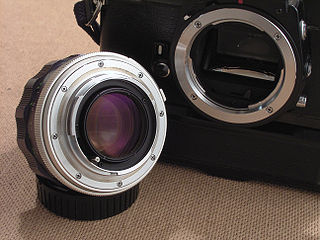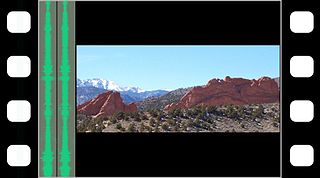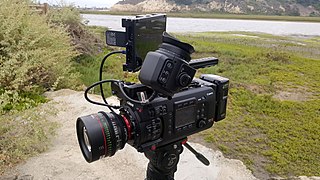Related Research Articles

Widescreen images are displayed within a set of aspect ratios used in film, television and computer screens. In film, a widescreen film is any film image with a width-to-height aspect ratio greater than the standard 1.37:1 Academy aspect ratio provided by 35 mm film.

70 mm film is a wide high-resolution film gauge for motion picture photography, with a negative area nearly 3.5 times as large as the standard 35 mm motion picture film format. As used in cameras, the film is 65 mm (2.6 in) wide. For projection, the original 65 mm film is printed on 70 mm (2.8 in) film. The additional 5 mm contains the four magnetic strips, holding six tracks of stereophonic sound. Although later 70 mm prints use digital sound encoding, the vast majority of existing and surviving 70 mm prints pre-date this technology.

CinemaScope is an anamorphic lens series used, from 1953 to 1967, and less often later, for shooting widescreen films that, crucially, could be screened in theatres using existing equipment, albeit with a lens adapter. Its creation in 1953 by Spyros P. Skouras, the president of 20th Century Fox, marked the beginning of the modern anamorphic format in both principal 2.55:1, almost twice as wide as the previously common Academy format's 1.37:1 ratio. Although the technology behind the CinemaScope lens system was made obsolete by later developments, primarily advanced by Panavision, CinemaScope's anamorphic format has continued to this day. In film-industry jargon, the shortened form, 'Scope, is still widely used by both filmmakers and projectionists, although today it generally refers to any 2.35:1, 2.39:1, 2.40:1, or 2.55:1 presentation or, sometimes, the use of anamorphic lensing or projection in general. Bausch & Lomb won a 1954 Oscar for its development of the CinemaScope lens.

Todd-AO is an American post-production company founded in 1953 by Mike Todd and Robert Naify, providing sound-related services to the motion picture and television industries. For more than five decades, it was the worldwide leader in theater sound. The company now operates one facility in the Los Angeles area.

A lens mount is an interface – mechanical and often also electrical – between a photographic camera body and a lens. It is a feature of camera systems where the body allows interchangeable lenses, most usually the rangefinder camera, single lens reflex type, single lens mirrorless type or any movie camera of 16 mm or higher gauge. Lens mounts are also used to connect optical components in instrumentation that may not involve a camera, such as the modular components used in optical laboratory prototyping which join via C-mount or T-mount elements.

Panavision is an American motion picture equipment company founded in 1953 specializing in cameras and lenses, based in Woodland Hills, California. Formed by Robert Gottschalk as a small partnership to create anamorphic projection lenses during the widescreen boom in the 1950s, Panavision expanded its product lines to meet the demands of modern filmmakers. The company introduced its first products in 1954. Originally a provider of CinemaScope accessories, the company's line of anamorphic widescreen lenses soon became the industry leader. In 1972, Panavision helped revolutionize filmmaking with the lightweight Panaflex 35 mm movie camera. The company has introduced other cameras such as the Millennium XL (1999) and the digital video Genesis (2004).
Robert Gottschalk was an American camera technician, inventor, and co-founder of Panavision.

The Genesis is a discontinued high-end digital movie camera developed by Panavision, and was available solely by rental. It is based on a proprietary Super 35 1.78:1 (16:9) aspect ratio, 12.4-megapixel, RGB filtered CCD sensor. It was first used by a feature crew to shoot Bryan Singer's Superman Returns, and was shortly followed up thereafter by the World War I film Flyboys. However, the computer effect-heavy nature of these two movies meant that ultimately the comedy Scary Movie 4 was the first theatrically released feature primarily shot with the Genesis. It was discontinued in 2012 and succeeded by the Millennium DXL line developed with Red Digital Cinema.
Super Panavision 70 is the marketing brand name used to identify movies photographed with Panavision 70 mm spherical optics between 1959 and 1983.
A PV mount is a lens mount developed by Panavision for use with both 16 mm and 35 mm film and digital movie cameras of various sensor sizes. It is one of the mounts offered with Panavision cameras and Panavision-designed lenses. Panavision also modifies ("Panavises") its third party camera and lens equipment in the interest of allowing clients to retain their personal preferences regarding equipment. As they are the only company who can offer this, customers wanting to use Panavision lenses on non-Panavision cameras or vice versa must rent this equipment directly through Panavision.
The Arriflex 435 is a movie camera product line created by Arri in 1995 to replace the Arriflex 35III line. The number reflects its position as a successor camera to the Arri III and the fact that it is designed for 35 mm film. The 435 cameras are specifically designed as MOS cameras, which means that they are conventionally considered to be too loud to record usable location sound. However, this also frees the camera up to be optimized for non-sync sound uses, particularly any filming which either doesn't require sound or shooting at non-sync speed, shooting in reverse, or ramping between different speeds. As such, its potential applications are widespread, and thus it is regularly used on music videos, commercials, second unit work on features, special effects work, and motion control, among other usage. Rival Panavision even owns more 435s for rental than Arri's own hire houses; Panavisions, however, can be converted to Pan-Arri 435s where they are modified to accept Panavision lenses and accessories. In recognition of the achievements of the 435 system, AMPAS awarded Arri a Scientific and Engineering Academy Award in 1999.

Ultra Panavision 70 and MGM Camera 65 were, from 1957 to 1966, the marketing brands that identified motion pictures photographed with Panavision's anamorphic movie camera lenses on 65 mm film. Ultra Panavision 70 and MGM Camera 65 were shot at 24 frames per second (fps) using anamorphic camera lenses. Ultra Panavision 70 and MGM Camera 65's anamorphic lenses compressed the image 1.25 times, yielding an extremely wide aspect ratio of 2.76:1.
Dean Raymond Cundey, A.S.C. is an American cinematographer and film director. He is known for his collaborations with John Carpenter, Steven Spielberg, Robert Zemeckis, as well as his extensive work in the horror genre, in addition to numerous family and comedy films. He was nominated for an Academy Award for Best Cinematography for his work on Who Framed Roger Rabbit and has been nominated for numerous BAFTAs and BSC Awards.
The Panavision HD-900F is the first digital high definition camera, able to record using the standard motion picture frame rate of 24 frames per second. It is the result of a collaboration of Panavision and Sony In 1997.

Anamorphic format is the cinematography technique of shooting a widescreen picture on standard 35 mm film or other visual recording media with a non-widescreen native aspect ratio. It also refers to the projection format in which a distorted image is "stretched" by an anamorphic projection lens to recreate the original aspect ratio on the viewing screen. The word anamorphic and its derivatives stem from the Greek anamorphoun, compound of morphé with the prefix aná. In the late 1990s and 2000s, anamorphic lost popularity in comparison to "flat" formats such as Super 35 with the advent of digital intermediates; however, in the years since digital cinema cameras and projectors have become commonplace, anamorphic has experienced a considerable resurgence of popularity, due in large part to the higher base ISO sensitivity of digital sensors, which facilitates shooting at smaller apertures.
Panavision has been a manufacturer of cameras for the motion picture industry since the 1950s, beginning with anamorphic widescreen lenses. The lightweight Panaflex is credited with revolutionizing filmmaking. Other influential cameras include the Millennium XL and the digital video Genesis.

A digital movie camera for digital cinematography is a video camera that captures footage digitally rather than the historically used movie camera, which shoots on film stock. Different digital movie cameras output a variety of different acquisition formats. Cameras designed for domestic use have also been used for some low-budget independent productions.
Richard Moore was an American cinematographer. In 1953, Moore teamed with Robert Gottschalk to co-found Panavision.